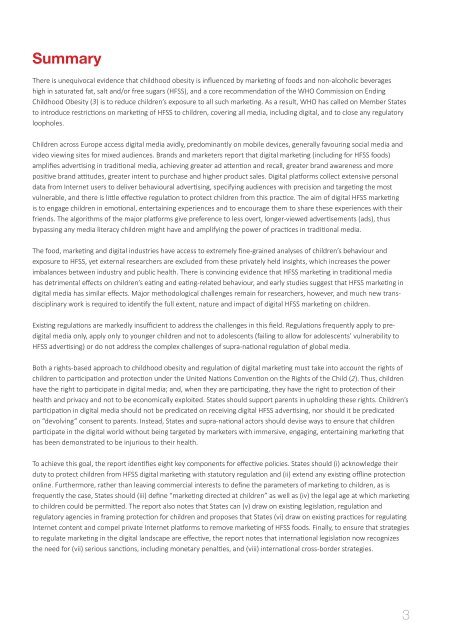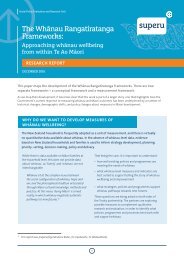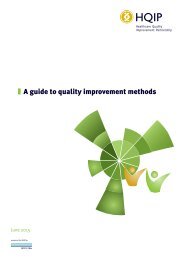2fyY1Py
2fyY1Py
2fyY1Py
You also want an ePaper? Increase the reach of your titles
YUMPU automatically turns print PDFs into web optimized ePapers that Google loves.
Summary<br />
There is unequivocal evidence that childhood obesity is influenced by marketing of foods and non-alcoholic beverages<br />
high in saturated fat, salt and/or free sugars (HFSS), and a core recommendation of the WHO Commission on Ending<br />
Childhood Obesity (3) is to reduce children’s exposure to all such marketing. As a result, WHO has called on Member States<br />
to introduce restrictions on marketing of HFSS to children, covering all media, including digital, and to close any regulatory<br />
loopholes.<br />
Children across Europe access digital media avidly, predominantly on mobile devices, generally favouring social media and<br />
video viewing sites for mixed audiences. Brands and marketers report that digital marketing (including for HFSS foods)<br />
amplifies advertising in traditional media, achieving greater ad attention and recall, greater brand awareness and more<br />
positive brand attitudes, greater intent to purchase and higher product sales. Digital platforms collect extensive personal<br />
data from Internet users to deliver behavioural advertising, specifying audiences with precision and targeting the most<br />
vulnerable, and there is little effective regulation to protect children from this practice. The aim of digital HFSS marketing<br />
is to engage children in emotional, entertaining experiences and to encourage them to share these experiences with their<br />
friends. The algorithms of the major platforms give preference to less overt, longer-viewed advertisements (ads), thus<br />
bypassing any media literacy children might have and amplifying the power of practices in traditional media.<br />
The food, marketing and digital industries have access to extremely fine-grained analyses of children’s behaviour and<br />
exposure to HFSS, yet external researchers are excluded from these privately held insights, which increases the power<br />
imbalances between industry and public health. There is convincing evidence that HFSS marketing in traditional media<br />
has detrimental effects on children’s eating and eating-related behaviour, and early studies suggest that HFSS marketing in<br />
digital media has similar effects. Major methodological challenges remain for researchers, however, and much new transdisciplinary<br />
work is required to identify the full extent, nature and impact of digital HFSS marketing on children.<br />
Existing regulations are markedly insufficient to address the challenges in this field. Regulations frequently apply to predigital<br />
media only, apply only to younger children and not to adolescents (failing to allow for adolescents’ vulnerability to<br />
HFSS advertising) or do not address the complex challenges of supra-national regulation of global media.<br />
Both a rights-based approach to childhood obesity and regulation of digital marketing must take into account the rights of<br />
children to participation and protection under the United Nations Convention on the Rights of the Child (2). Thus, children<br />
have the right to participate in digital media; and, when they are participating, they have the right to protection of their<br />
health and privacy and not to be economically exploited. States should support parents in upholding these rights. Children’s<br />
participation in digital media should not be predicated on receiving digital HFSS advertising, nor should it be predicated<br />
on “devolving” consent to parents. Instead, States and supra-national actors should devise ways to ensure that children<br />
participate in the digital world without being targeted by marketers with immersive, engaging, entertaining marketing that<br />
has been demonstrated to be injurious to their health.<br />
To achieve this goal, the report identifies eight key components for effective policies. States should (i) acknowledge their<br />
duty to protect children from HFSS digital marketing with statutory regulation and (ii) extend any existing offline protection<br />
online. Furthermore, rather than leaving commercial interests to define the parameters of marketing to children, as is<br />
frequently the case, States should (iii) define “marketing directed at children” as well as (iv) the legal age at which marketing<br />
to children could be permitted. The report also notes that States can (v) draw on existing legislation, regulation and<br />
regulatory agencies in framing protection for children and proposes that States (vi) draw on existing practices for regulating<br />
Internet content and compel private Internet platforms to remove marketing of HFSS foods. Finally, to ensure that strategies<br />
to regulate marketing in the digital landscape are effective, the report notes that international legislation now recognizes<br />
the need for (vii) serious sanctions, including monetary penalties, and (viii) international cross-border strategies.<br />
3






